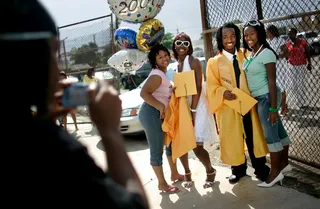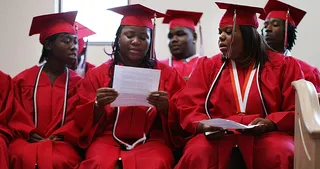Snapshot of Black America
Facts behind Black healthcare, graduation rates and more.

1 / 16
Our Community at a Glance - Using the data collected during the 2010 census, the U.S. Census Bureau has compiled a series of statistics on the state of Black America in the areas of population growth, poverty levels, education, employment and other vital areas. Read on for an unprecedented snapshot of Black America.—Britt Middleton

2 / 16
Growth Ahead - $135.7 billion: Receipts for Black-owned businesses in 2007, up 53.1 percent from 2002. The number of Black-owned businesses totaled 1.9 million in 2007, up 60.5 percent. Source: 2007 Survey of Business Owners (Photo: REUTERS/Tim Gaynor)

3 / 16
Tech Savvy - 28.4 percent: The percentage of Blacks 16 and older who work in management, business, science and arts occupations. Source: 2010 American Community Survey (Photo: Getty Images)

4 / 16
Homestead - 44.2 percent: Nationally, the percentage of households with a householder who is Black and who lives in owner-occupied homes. Source: 2010 American Community Survey (Photo: REUTERS/Joe Skipper)

5 / 16
Strong Foundation - 44.4 percent: Among families with Black householders, the percentage that were married couples. Source: 2011 Families and Living Arrangements, Table F1 (Photo: Mario Tama/Getty Images)
ADVERTISEMENT

6 / 16
In Good Hands - 79.2 pecent: Percentage of Blacks that were covered by health insurance during all or part of 2010. Source: U.S. Census Bureau 2010 Income, Poverty and Health Insurance Coverage in the United States. (Photo: Joe Raedle/Getty Images)

7 / 16
Poverty in Black America - 27.4 percent: Poverty rate in 2010 for Blacks. Source: U.S. Census Bureau, Income, Poverty and Health Insurance Coverage in the United States: 2010 (Photo: Mario Tama/Getty Images)

8 / 16
Income Disparities - $32,068: The annual median income of Black households in 2010, a decline of 3.2 percent from 2009. Source: U.S. Census Bureau 2010 Income, Poverty and Health Insurance Coverage in the United States. (Photo: Mario Tama/Getty Images)

9 / 16
Strength in Numbers - 65 percent: Turnout rate among Black citizens regardless of age in the 2008 presidential election, up about five percentage points from 2004. Looking at voter turnout by race and Hispanic origin, non-Hispanic whites and Blacks had the highest turnout levels. Source: Voting and Registration in the Election of 2008 (Photo: REUTERS/Joshua Roberts)

10 / 16
Heading to the Polls - 11.1 million: The number of Blacks who voted in the 2010 congressional election, an increase from 11 percent of the total electorate in 2006 to 12 percent in 2010. Source: Voting and Registration in the Election of 2010 (Photo: Mario Tama/Getty Images)
ADVERTISEMENT

11 / 16
Rocking the Vote - 55 percent: Turnout rate in the 2008 presidential election for the 18- to 24-year-old Black population, an eight percentage point increase from 2004. Blacks had the highest turnout rate in this age group. Source: Voting and Registration in the Election of 2008. (Photo: Mario Tama/Getty Images)

12 / 16
True Identity - 42 million: The number of people who identified as Black, either alone or in combination with one or more other races, in the 2010 Census. They made up 13.6 percent of the total U.S. population. The Black population grew by 15.4 percent from 2000 to 2010. Source: The Black Population: 2010 (Photo: Getty Images)

13 / 16
Future Projections - 65.7 million: The projected Black population of the United States (including those of more than one race) for July 1, 2050. On that date, according to the projection, Blacks would constitute 15 percent of the nation's total population. Source: Population Projections (Photo: Mario Tama/Getty Images)

14 / 16
Great Graduates - 82 percent: Among Blacks 25 and older, the percentage with a high school diploma or higher in 2010. Source: 2010 American Community Survey (Photo: Mario Tama/Getty Images)
Photo By Photo: Mario Tama/Getty Images

15 / 16
Higher Learning - 18 percent: Percentage of Blacks 25 and older who had a bachelor's degree or higher in 2010. Source: 2010 American Community Survey (Photo: Mario Tama/Getty Images)
Photo By Photo: Mario Tama/Getty Images
